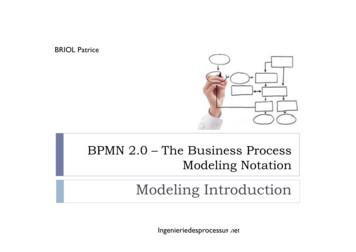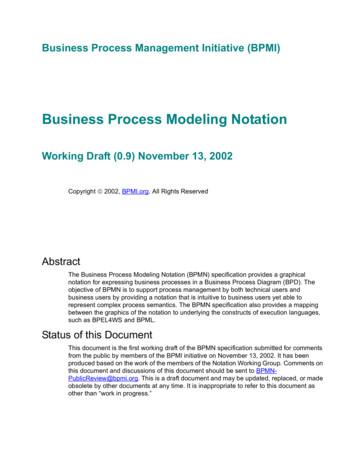Business Process Modeling Notation - CoverPages
Business Process Management Initiative (BPMI)Business Process Modeling NotationWorking Draft (1.0) August 25, 2003Copyright 2003, BPMI.org. All Rights ReservedAbstractThe Business Process Modeling Notation (BPMN) specification provides a graphicalnotation for expressing business processes in a Business Process Diagram (BPD). Theobjective of BPMN is to support process management by both technical users andbusiness users by providing a notation that is intuitive to business users yet able torepresent complex process semantics. The BPMN specification also provides a mappingbetween the graphics of the notation to underlying the constructs of execution languages,particularly BPEL4WS.Status of this DocumentThis document is the first working draft of the BPMN specification submitted for commentsfrom the public by members of the BPMI initiative on August 25, 2003. It supersedes anyprevious version. It has been produced based on the work of the members of the BPMINotation Working Group. Comments on this document and discussions of this documentshould be sent to BPMN-PublicReview@bpmi.org. This is a draft document and may beupdated, replaced, or made obsolete by other documents at any time. It is inappropriate torefer to this document as other than “work in progress.”
BPMN Working DraftAcknowledgementsThe author/editor of the specification:Stephen A. White, IBM (wstephe@us.ibm.com)The members of the BPMI Notation Working Group contributed to the development of thisspecification, including those who contributed to the editing of the specification:Ashish Agrawal, Intalio (ashish@intalio.com)Michael Anthony, International Performance Group (manthony@ipgl.com)Assaf Arkin, Intalio (arkin@intalio.com)Tony Fletcher, Choreology (Tony.Fletcher@choreology.com)Steven Forgey, SeeBeyond Technology Corporation (sforgey@seebeyond.com)Jean-Luc Giraud, Axway Software (jlgiraud@axway.com)George Keeling, Casewise (george@casewise.co.uk)Brian James, Proforma (bjames@proformacorp.com)Antoine Lonjon, Mega International (alonjon@mega.com)Martin Owen, Popkin Software (martin.owen@popkin.co.uk)Manfred Sturm, ITPearls AG (manfred.sturm@itpearls.com)Steve Ball, Sterling Commerce (steve ball@stercomm.com)Paul Vincent, Fair, Isaac & Company (paulvincent@fairisaac.com)The members of the BPMI Notation Working Group would like to thank SeeBeyondTechnology Corporation for their valuable support in the development of this specification.Notice of BPMI.org Policies on Intellectual Property Rights &CopyrightBPMI.org takes no position regarding the validity or scope of any intellectual property orother rights that might be claimed to pertain to the implementation or use of the technologydescribed in this document or the extent to which any license under such rights might ormight not be available; neither does it represent that it has made any effort to identify anysuch rights. Information on BPMI.org's procedures with respect to rights in BPMI.orgspecifications can be found at the BPMI.org website. Copies of claims of rights madeavailable for publication and any assurances of licenses to be made available, or the resultof an attempt made to obtain a general license or permission for the use of such proprietaryrights by implementers or users of this specification, can be obtained from the BPMI.orgChairman.BPMI.org invites any interested party to bring to its attention any copyrights, patents orpatent applications, or other proprietary rights, which may cover technology that may berequired to implement this specification. Please address the information to the BPMI.orgChairman.This document and translations of it may be copied and furnished to others, and derivativeworks that comment on or otherwise explain it or assist in its implementation may be2 / 189Copyright 2003, BPMI.org All Rights Reserved
BPMN Working Draftprepared, copied, published and distributed, in whole or in part, without restriction of anykind, provided that the above copyright notice and this paragraph are included on all suchcopies and derivative works. However, this document itself may not be modified in any way,such as by removing the copyright notice or references to BPMI.org, except as needed forthe purpose of developing BPMI.org specifications, in which case the procedures forcopyrights defined in the BPMI.org Intellectual Property Rights document must be followed,or as required to translate it into languages other than English.The limited permissions granted above are perpetual and will not be revoked by BPMI.orgor its successors or assigns.This document and the information contained herein is provided on an "AS IS" basis andBPMI.org DISCLAIMS ALL WARRANTIES, EXPRESS OR IMPLIED, INCLUDING BUTNOT LIMITED TO ANY WARRANTY THAT THE USE OF THE INFORMATION HEREINWILL NOT INFRINGE ANY RIGHTS OR ANY IMPLIED WARRANTIES OFMERCHANTABILITY OR FITNESS FOR A PARTICULAR PURPOSE.Copyright The Business Process Management Initiative [BPMI.org], August 25, 2003. AllRights Reserved.Copyright 2003, BPMI.org All Rights Reserved3 / 189
BPMN Working DraftTable of ContentsAbstract.1Status of this Document.1Acknowledgements .2Notice of BPMI.org Policies on Intellectual Property Rights & Copyright .2Table of Contents .4List of Figures.8List of Tables .12List of Examples.131. Introduction.141.1 Conventions .151.1.1 Typographical and Linguistic Conventions and Style .151.2 Dependency on Other Specifications.161.3 Conformance .162. BPMN Overview .192.1 BPMN Scope.202.1.1 Uses of BPMN .202.1.2 Diagram Point of View .232.1.3 Extensibility of BPMN and Vertical Domains .243. Business Process Diagrams .253.1 BPD Core Element Set .253.2 BPD Complete Set.273.3 Use of Text, Color, Size, and Lines in a Diagram .343.4 Flow Object Connection Rules .353.4.1 Sequence Flow Rules.353.4.2 Message Flow Rules .363.5 Diagram Attributes.374. Business Process Diagram Graphical Objects .394.1 Common BPD Object Attributes.394.2 Events .394.2.1 Start .404.2.2 End .444.2.3 Intermediate .484.3 Activities .524.3.1 Process .524.3.2 Sub-Process.544.3.3 Task.604.4 Gateways.644 / 189Copyright 2003, BPMI.org All Rights Reserved
BPMN Working DraftTable of Contents4.4.1 Common Gateway Features.664.4.2 Exclusive Gateways (XOR).674.4.3 Inclusive Gateways (OR).754.4.4 Complex Gateways .784.4.5 Parallel Gateways (AND) .814.5 Pools and Lanes.834.5.1 Pool .834.5.2 Lane .864.6 Artifacts .874.6.1 Common Artifact Attributes .884.6.2 Artifact Sequence Flow Connections .884.6.3 Artifact Message Flow Connections.884.6.4 Data Object .884.6.5 Text Annotation .904.6.6 Group .915. Connecting Objects.935.1 Graphical Connecting Objects .935.1.1 Sequence Flow .935.1.2 Message Flow .965.1.3 Association.995.2 Sequence Flow Mechanisms.1015.2.1 Normal Flow .1025.2.2 Link Events .1215.2.3 Exception Flow .1215.2.4 Ad Hoc .1225.3 Compensation Association .1246. BPMN by Example .1276.1 The Beginning of the Process .1286.1.1 Mapping to BPEL4WS .1286.2 The First Sub-Process.1336.2.1 Mapping to BPEL4WS .1356.3 The Second Sub-Process.1396.3.1 Mapping to BPEL4WS .1416.4 The End of the Process .1466.4.1 Mapping to BPEL4WS .1477. Mapping to XML Languages.1537.1 Defining Token Generation for execution Language Mapping.1537.2 Mapping to BPEL4WS .1547.2.1 Events.1547.2.2 Activities .1577.2.3 Gateways.159Copyright 2003, BPMI.org All Rights Reserved5 / 189
BPMN Working Draft7.2.4 Pool .1617.2.5 Lane .1617.2.6 Artifacts .1617.2.7 Sequence Flow .1617.2.8 Message Flow .1627.2.9 Association.1627.2.10 Exception Flow .1627.2.11 Compensation Flow .1638. References.1658.1 Normative .1658.2 Non-Normative.1659. Open Issues .169Appendix A: E-Mail Voting Process BPEL4WS .171Appendix B: Glossary.1796 / 189Copyright 2003, BPMI.org All Rights Reserved
BPMN Working DraftCopyright 2003, BPMI.org All Rights ReservedTable of Contents7 / 189
BPMN Working DraftList of FiguresFigure 1: A Business Process Diagram with Two Points of View .23Figure 2: A Start Event .40Figure 3: End Event.44Figure 4: Intermediate Event.48Figure 5: Task with an Intermediate Event attached to its boundary.49Figure 6: Collapsed Sub-Process .54Figure 7: Expanded Sub-Process.54Figure 8: Expanded Sub-Process used as a “parallel box” .55Figure 9: Collapsed Sub-Process Markers .55Figure 10: An Example of a Transaction Expanded Sub-Process .58Figure 11: A Task Object .61Figure 12: Task Markers .61Figure 13: A Gateway.65Figure 14: The Different types of Gateways.66Figure 15: A
The Business Process Modeling Notation (BPMN) specification provides a graphical notation for expressing business processes in a Business Process Diagram (BPD). The objective of BPMN is to support process management by both technical users and business users by providing a notation that is
It's Practice with Scientific Notation! Review of Scientific Notation Scientific notation provides a place to hold the zeroes that come after a whole number or before a fraction. The number 100,000,000 for example, takes up a lot of room and takes time to write out, while 10 8 is much more efficient.File Size: 290KBPage Count: 8People also search forscientific notation worksheet answersscientific notation worksheet keyscientific notation worksheet pdf answersscientific notation worksheet with answersscientific notation worksheetscientific notation worksheet with answer key
The Business Process Modeling Notation (BPMN) is a standard for business process modeling that provides a graphical notation for specifying business processes in a Business Process Diagram (BPD). The notation is based on a flowcharting technique. The objective of BPMN is to support business
Recall the definition for scientific notation 1. Change these LARGE scientific notation numbers to standard notation and vice versa. Make up a number for the blank cells. Scientific Notation Standard Notation Scientific Notation Standard Notation a. 6.345 10 e. 5,320 b. 8.04 10 % f. 420,000 c. 4.26 10 & g. 9,040,000,000 d. h. 2. Now try .
Figure 3: Results of Business Process Modeling Figure 2: Process model for each individual process About bPMn Figure 4: Activity types and markers BPMN (Business Process Modeling Notation) is a graphical notation for business process modeling. The objective of BPMN is to support business process modeling
The Business Process Modeling Notation (BPMN) specification provides a graphical notation for expressing business processes in a Business Process Diagram (BPD). The objective of BPMN is to support process management by both technical users and business users by providing a notation that is
Scientific Notation (SN)- A shorthanded way of writing really large or really small numbers. In SN a number is written as the product of two factors. !Ex: 280,000,000 can be written in scientific notation as 2.8!!!10. First Factor Regular Notation ! Scientific Notation Regular Notation How to Change Scientific Notation 420,000.
Modeling Business Processes for SOA 27 Mar. 2006 page 15 Business Process Modeling Notation (BPMN) Graphical notation for process modeling Designed for business users Platform independent Proof of concept mapping to BPEL Implemented in a number of process modeling produ
Automotive Council The Advanced Propulsion Centre Thermal Efficiency and System Efficiency Spokes, supported by an expert Steering Group, helped to shape the roadmap before and after the workshop. Pre-event Common Assumptions Briefing Breakout Sessions Collective Briefing Process Post-Event Debrief Pre-Event Email 1 day workshop with 45 attendees Post-Event Email Thermal Propulsion Systems .























